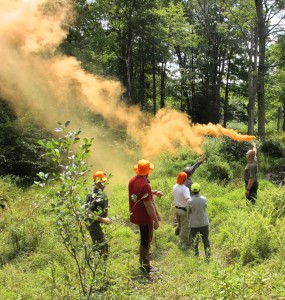Signaling Equipment – Smoke Flare
At True North we regularly explain to our clients that when it comes to being rescued, it is the responsibility of the survivor to the best of one’s ability to assist in being found. No matter how well equipped rescuers may be, you still remain the proverbial needle in the haystack. Even if they have helicopters with the latest in technological equipment, they could easily continue to fly above you and never even notice that you’re there. After all, you are so very small while the world is so very big. As a survivor, therefore, your ability is vastly improved when you are prepared with the appropriate gear, skills, and knowledge. So, you may want to consider adding a flare to your survival kit.
In particular, during our recent Advanced Wilderness Survival course, I wanted to experiment with a good visual signal, the smoke-flare. Such a signaling device is intended for day use only since, well, smoke isn’t seen too well at night.
When it comes to signaling devices, I am biased towards products made by ACR Electronics, which manufactures a wide array of signaling devices for marine, aviation, outdoor, and military use. So I chose for this experiment their Aurora Orange Smoke Signal, which I purchased from one of their distributors, West Marine, for $29.99.
ACR describes this product as:
Manufactured by the world leader in marine pyrotechnics, the Aurora Smoke Flare commands attention with its intense orange smoke. The protective handle and no-strike ignition provides for safer activation.
During its 1-minute burn time, the Aurora Smoke Flare generates a hard-to-miss cloud of dense orange smoke that draws immediate attention to your distress situation. It is USCG-approved as a daytime signal, and is manufactured marine-tough to withstand exceptional environmental exposure. This robust signal flare will even perform after total immersion in water. To activate, simply remove the cap at the base of the ergonomic protective handle and pull the wire igniter sharply.
I was fairly impressed by this product: it was simple and easy to use, and generated a lot of smoke.
 Still, our location at the time in the woods underscored that this product really is intended for marine use, not amongst a forested area, since the smoke, despite its amount and color, would not have significantly risen above the canopy to catch a pilots attention. Rather, this flare is definitely best used for areas that are wide and open, like the ocean, or perhaps even in a tundra or desert environment, when rescuers are in your vicinity.
Still, our location at the time in the woods underscored that this product really is intended for marine use, not amongst a forested area, since the smoke, despite its amount and color, would not have significantly risen above the canopy to catch a pilots attention. Rather, this flare is definitely best used for areas that are wide and open, like the ocean, or perhaps even in a tundra or desert environment, when rescuers are in your vicinity.
Our experiment was also a good reminder of the importance of knowing how to use your signaling equipment before the actual emergency. Even though this flare only requires three simple steps, I could see the difficulty in using it for the first time under stress. Also, this test allowed me to see firsthand how important the landscape is on the efficacy of the flare.
In any case, I bought an extra flare so that I can include it in my survival kit (next to my ACR Aqualink PLB) for my next ocean or desert adventure. Though the price tag seems a bit steep, I could see myself in an actual emergency looking at this orange smoke as being priceless.

